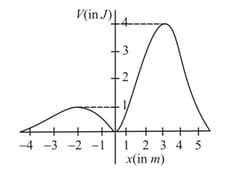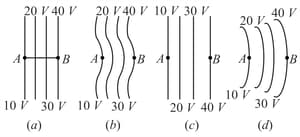EASY
Earn 100
A 100 eV electron is fired directly towards a large metal plate having surface charge density The distance from where the electrons be projected so that it just fails to strike the plate is
(a)0.22mm
(b)0.44mm
(c)0.66mm
(d)0.88mm
50% studentsanswered this correctly
Important Questions on Electrostatics
EASY
An electric field exists in a region of space. If the potential at the origin is taken to be zero then the potential at , is:
MEDIUM
A charge is distributed over three concentric spherical shells of radii such that their surface charge densities are equal to one another.
The total potential at a point at distance from their common centre, where would be:
MEDIUM
A charge Q is uniformly distributed over a long rod AB of length L as shown in the figure. The electric potential at the point O lying at a distance L from the end A is :

MEDIUM
Two equal charges of magnitude each are placed at a distance apart. Their electrostatic energy is third charge is brought midway between these two charges. The electrostatic energy of the system is now?
HARD
An electric dipole lies in an electric field in such a position that its dipole moment is It is rotated so that the dipole moment becomes The work done by the external agent is
EASY
A metallic sphere is kept in between two oppositely charged plates. The most appropriate representation of the field lines is
EASY
If potential(in ) in a region is expressed as , the electric field(in ) at point is
MEDIUM
A certain p-n junction having a depletion region of width was found to have a breakdown voltage of . If the width of the depletion region is reduced to during its production, then it can be used as a zener diode for voltage regulation of:
EASY
A large metal plate has a surface charge density of . An electron having initial kinetic energy of is moving towards the center of the plate. If the electron stops just before reaching the plate then the initial distance between the electron and the plate is [Take ]
MEDIUM
When an -particle of mass moving with a undefined velocity bombards on a heavy nucleus of charge , its distance of the closest approach from the nucleus depends on as:
EASY
An electron with an initial speed of is brought to rest by an electric field. The mass and charge of an electron are and , respectively. Identify the correct statement.
MEDIUM
An electric dipole of dipole moment is placed parallel to the uniform electric field of intensity On rotating it through the amount of work done is _______.
MEDIUM
There is a uniform electrostatic field in a region. The potential at various points on a small sphere centred at , in the region, is found to vary between the limits to . What is the potential at a point on the sphere whose radius vector makes an angle of with the direction of the field?
MEDIUM
Consider a cube of uniform charge density, . The ratio of the electrostatic potential at the center of the cube to that at one of the corners of the cube is,
HARD
A point particle of mass is moving along the -axis under a force described by the potential energy shown below. It is projected towards the right from the origin with a speed .

What is the minimum value of for which the particle will escape infinitely far away from the origin?
EASY
The diagrams below show regions of equipotential.

A positive charge is moved from to in each diagram.
HARD
Consider a spherical shell of radius with a total charge uniformly spread on its surface (center of the shell lies at the origin ). Two point charge, are brought, one after the other, from far away and placed at respectively. Magnitude of the work done in this process is
HARD
Four equal point charges each are placed in the plane at and . The work required to put a fifth charge at the origin of the coordinate system will be:
MEDIUM
An electric dipole of dipole moment is placed in a uniform electric field of strength . If is the angle between the positive direction of and , then potential energy of the dipole is largest when is
HARD
A point charge is carried from a point to another point on the axis of a charged ring of radius carrying a charge If the point is at a distance from the centre of the ring and the point is from the centre but on the opposite side, what is the net work that need to be done for this?

